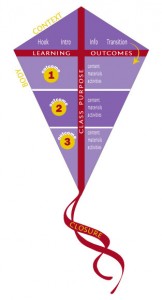Designing An Online Course?
The two steps below will help you build a strong, effective course. I’m going to suggest that as you build it, you think of your course in the shape of a traditional, diamond-shaped kite. This metaphor will help your brain “get it,” and make instructional design easy and efficient…not to mention fun.
Let’s begin with the frame. That’s the strong, T-shaped structure that holds the Kite (and your course) together. Without this frame, your course cannot get off the ground.
1. Develop a purpose statement.
This is the first strut of your Kite, the vertical part of the frame you can see in the picture. State in clear language who your audience is and what the topic is. The statement should be fairly broad. Here are 2 real-life examples:
The purpose of this training session is to help front-line supervisors write e-mails more clearly and concisely.
The purpose of this training session is to teach clients how to effectively use Calypso software .
By clearly stating your purpose, you provide yourself with a clear focus as your develop the course. Any content outside this focus lies outside the session’s purview, so leave it out. This helps you focus only on the course’s “must-know” elements. You may find it surprisingly challenging to write a simple, straightforward purpose statement.
2. Ask yourself, “What will the learners be able to DO by the end of this session?”
This is your Kite’s horizontal strut. First, state in clear language who your audience is and what the topic is. Keep in mind your course’s length.
As an example, let’s say that the first example above (The purpose of this training session is to help front-line supervisors write e-mails more clearly and concisely) is for a one-hour Webinar. For this outcome, you might say:
By the end of this Webinar, front-line supervisors will be able to:
- Explain at least five etiquette rules for writing clear e-mails.
- Correct basic punctuation in several e-mails, and be able to describe the rules used.
- Compose and send an e-mail that integrates these etiquette and punctuation rules.
ALL your content will "hang" from these outcomes, just as fabric stretches over the framework of a kite. Simply develop content and online activities that enable your learners to achieve each outcome. Keep focused on the Purpose, and you can’t go wrong.
Instructional design is not an overly difficult task. By following the steps above, it can be as easy as flying a kite.
Would you like to flying high with the kite method of Instructional Design? Please check the Instructional Design That Soars: Shaping What You Know Into Classes That Inspire to find out more.


